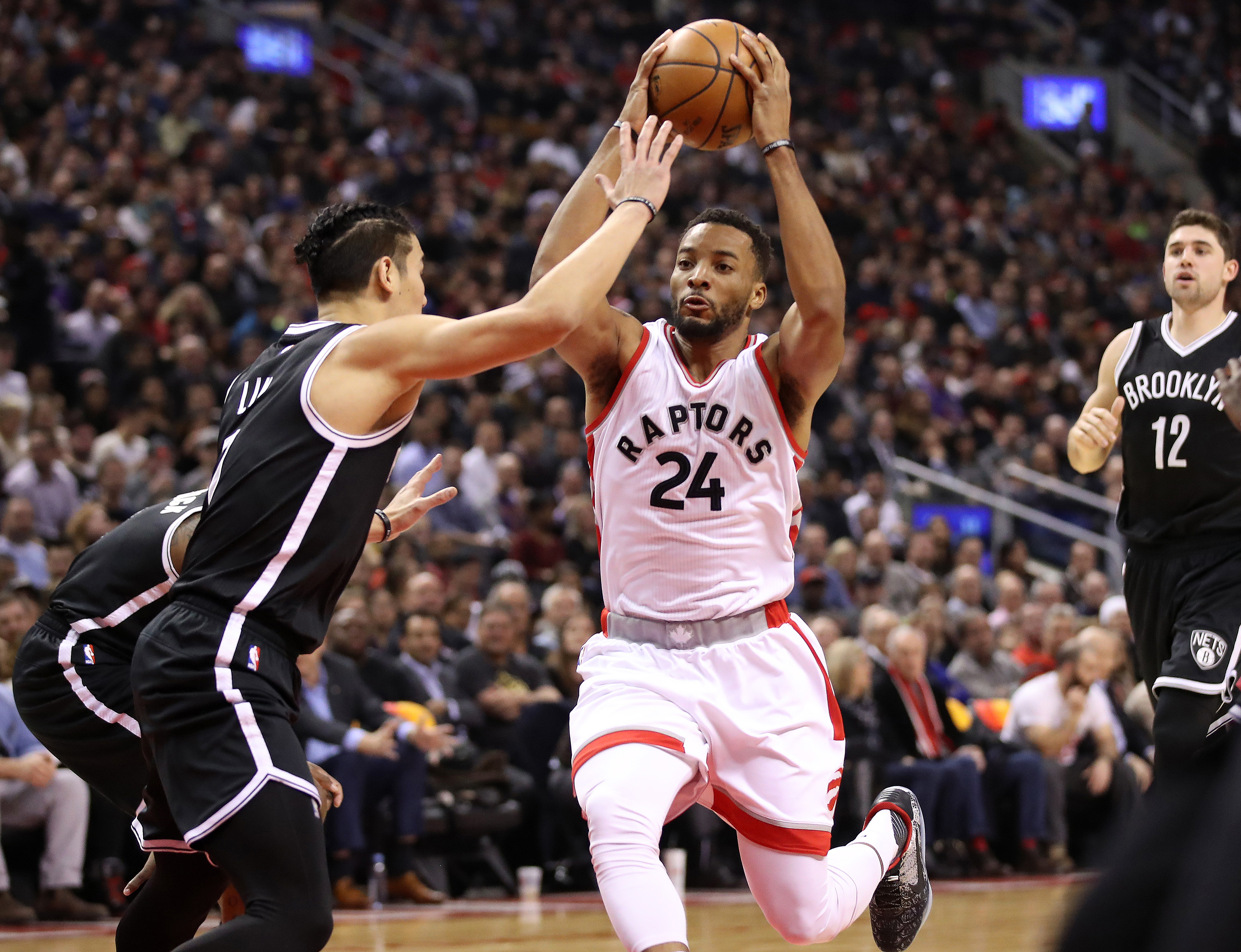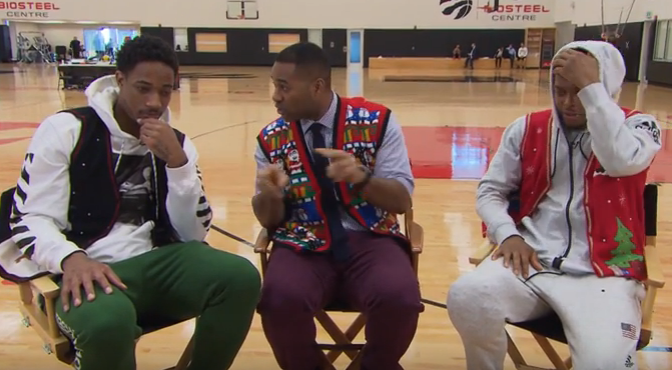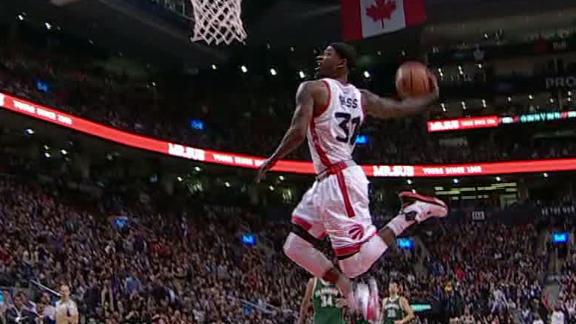With five minutes to play against the Brooklyn Nets on Tuesday, Toronto Raptors head coach Dwane Casey grew comfortable with the team’s double-digit lead and turned to the bench. First, Jakob Poeltl checked into the game, giving the team’s centers a reprieve for the closing stretch. Then Fred VanVleet and Bruno Caboclo completed their double-header, ending the night for Terrence Ross and Pascal Siakam. Casey had emptied his bench, but there remained Norman Powell.
This has become somewhat of a common occurrence as the Raptors learn to blowout lesser competition. While Lucas Nogueira has “graduated” from the garbage-time unit, in Powell’s words, a pair of injuries and occasional D-League assignments leave the Raptors with a thinner bench some nights. On nights like Tuesday, when Patrick Patterson is also sitting for rest, Casey has little choice but to let Powell close things out, even if he’s been a major factor in building the substantial lead that allows for the bench to be emptied in the first place. That was the case Tuesday, as Powell contributed 21 points and five steals in 27 minutes off the bench.
Powell, of course, is much too good for don’t-call-it-garbage-time. That he’s also not getting regular rotation minutes commensurate with his level of play is one of the more egregious demonstrations of the Raptors’ embarrassment of depth at the guard positions, and it’s left Powell to navigate his way back-and-forth between roles.
At times, that means working with the team’s stars in DeMar DeRozan and Kyle Lowry. With two fairly ball-dominant players on the floor together and spacing sometimes at a premium, those instances require Powell to spot up, knock down any open looks, and attack close-outs aggressively.
When he’s been asked to do so, the results have been a sabermetrician’s dream – Powell’s taking more than half of his attempts from beyond the 3-point line when playing with both stars, he’s posting a robust true-shooting percentage of 61, and he ranks in the top-10 in the NBA in points per-possession, per Synergy Sports. A significant part of his success comes from canning 43.2 percent of his 3-point looks, and the NBA sample with his re-tooled jumper is growing large enough (41.4 percent on 133 attempts) that opponents have to start considering him more of a threat.
When Powell plays with just one of the stars, his usage doesn’t increase but his role changes slightly, shifting from spot-up mode to being the second attacker on the floor. In those lineups, his free-throw rate has spiked, and he’s essentially been able to play a lower-usage DeRozan role alongside Lowry. That shouldn’t be surprising given who he’s been trying to learn from during his first two years in the league, and he’s clearly picking up some tricks for drawing fouls.
“I talk to DeMar all the time,” Powell told Raptors Republic after Tuesday’s victory. “His approach to the game and how he do what he do, he’s looking to get to the free-throw line in his attack. So I’m trying to do the same thing.”

Per NBAWowy.com. Note that their Net Ratings may be a little off from NBA.com due to a difference in how possessions are calculated. NBA.com has Powell’s Net Rating at 13.5 overall, so these numbers may actually be understated. (FTr is free throw attempts per-field goal attempt, PPP is points per-possession, and % of 3FGA indicates the share of a player’s shots that come from behind the arc.)
Other times, Powell’s position in the rotation means propping up bench-heavy units light on playing time and shot-creation, which requires an entirely different mentality than his other role. The samples get noisy in those cases, given the quality of competition that might be on the floor or the score effects that might be at play. Still, if Casey is going to try to steal minutes with both stars on the bench at any point, Powell’s sustained efficiency numbers when they hit the bench has to be encouraging. So, too, is the way he leads those inexperienced end-of-game groups.
“You see a bunch of different shots up when I’m with the second unit. I’m able to attack, play off the dribble more, get to the rim, and make plays,” Powell said. “It’s just making reads on who I’m out there with.”
Wearing both hats is something Powell struggled with in the preseason. He went from being a major focus in the D-League to being a role player for the Raptors’ stretch run and then back to being the No. 1 option all offseason, and the drastic difference between roles takes an adjustment period. That adjustment period is growing shorter and shorter each time he changes masks, and the returns through one third of the NBA season are beyond encouraging. He’s proving to be an effective cog with the team’s primary group and a capable leader of its second unit, blending in well with just about any four-some his coach asks him to play with.
“When you go from being the man – talking to the young guys, and leading the team in Summer League, being a focal point – to having to adjust to Kyle and DeMar, it’s trying to feel and get that flow and chemistry back,” Powell said. “After preseason, I was able to get back into that adjustment of doing what the team needs and being able to be versatile with my approach, and the way I’m playing with the starting unit and the second unit.”
Powell’s ability to switch between roles highlights a general versatility about his game that’s important not just for the team, but for his playing time. Capable of guarding ones and twos, Powell’s embraced the challenge to check larger small forwards like Carmelo Anthony, and Casey’s even gotten aggressive using Powell as the de facto power forward in multi-wing lineups. Those groups struggle to rebound, but they push the pace in transition, score a ton, and give the Raptors another look to throw at opponents that might come in handy as postseason matchups dictate.
From an individual standpoint, all of these ways in which Powell can contribute open up multiple paths to playing time. Some nights, he may only get close-out minutes. Others, he’ll start for a resting DeMarre Carroll. Smaller lineups, spot-starting, garbage time, or as a matchup defender, it’s hard to tell how much Powell might play game-to-game. That’s his unfortunate lot with the team’s depth, with Carroll healthy, and with Terrence Ross playing well for the most part, but every chance he’s given, Powell’s showing Casey that he can be used in more and more situations, almost demanding the rotation extend to 10 players.
“I pride myself on not only being a two-way player, but versatile,” Powell said. “Whatever the team needs, whatever it’s going to take me to get on the floor. Whatever is in front of me, I take it as an opportunity to show what I can do.”
At this point, the Raptors know what Powell can do: He can defend better than maybe any other player on the team, he can be lethal in a low-usage role with the stars, and he can lead bench-heavy units as a primary weapon. He’s a defensive specialist, sure, but that’s too narrow a role card given the growth he’s shown at the other end of the floor. The question is starting to shift to what Powell can’t do, and there’s not a good answer yet.



